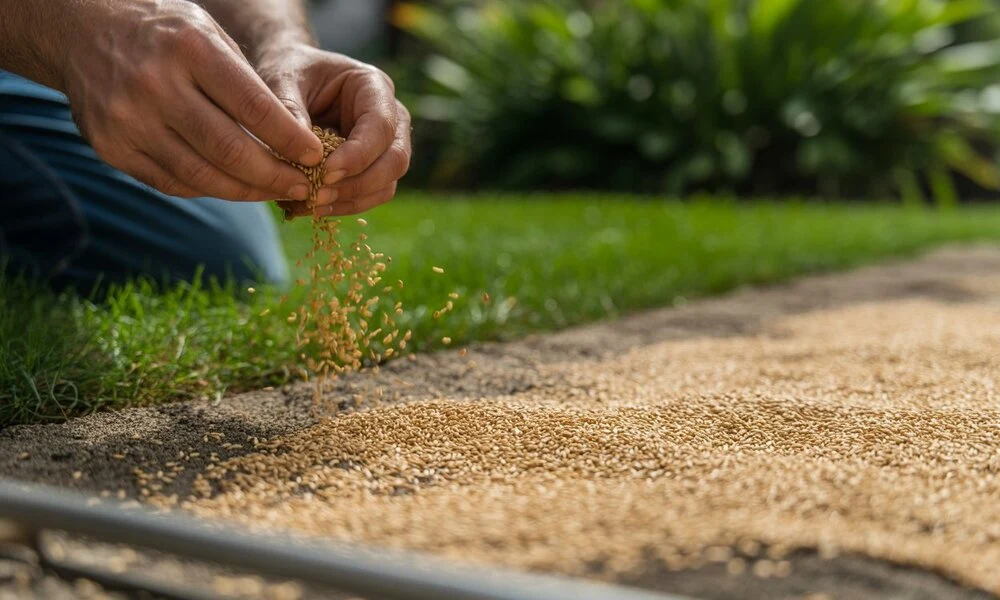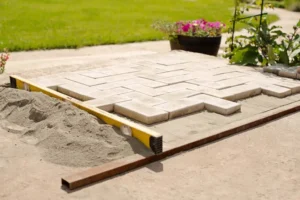How do you seed a lawn the right way? Growing a healthy, green yard starts with properly planting grass seed. Whether you’re starting a new lawn or fixing bare spots, seeding a lawn takes more than just spreading seeds. You need to get the ground ready, spread the seeds correctly, and take care of the lawn as it grows. In this guide, we’ll explain each step how to prepare the ground for planting, what to use after spreading the seeds, and how long grass seeds take to sprout. Follow along to grow a lawn you’ll be proud of.
Preparing the Ground for Planting Grass Seed

Proper ground preparation is key to successful lawn seeding. To prepare your soil for grass seed sowing, follow these easy procedures.
1. Clear the Area
Remove any existing grass, weeds, rocks, or debris. This ensures that your grass seed has the best chance to take root without competing plants.
2. Test and Improve the Soil
Check your soil’s pH and nutrient levels using a soil test kit. Based on the results, add necessary amendments like compost, lime, or fertilizer to create healthy growing conditions for lawn seeding.
3. Loosen the Soil
Compacted areas can be broken up by tilling or aerating the soil. This helps improve drainage and allows planting grass seed to make direct contact with the soil, boosting germination rates.
4. Level the Surface
Rake the area smooth to create an even base. A level surface supports uniform seed distribution and consistent grass growth during the lawn seeding process.
You may successfully sow grass seed and create a beautiful, green lawn by carefully preparing your soil.
Step-by-Step | How Do You Seed a Lawn

Seeding a lawn is a simple but detailed process that ensures a healthy, green yard for seasons to come. Whether you’re starting from scratch or overseeding an existing lawn, follow these step-by-step instructions to get the best results with your lawn seeding project.
Step 1: Choose the Right Grass Seed
The key to successfully planting a lawn is choosing the right grass seed. Consider your region’s climate, the amount of sunlight your lawn gets, and how much foot traffic the area receives.
- Cool-season grasses (like Kentucky bluegrass, fescue, or ryegrass) are ideal for northern regions.
- Warm-season grasses (like Bermuda, zoysia, or St. Augustine) thrive in southern climates.
Make sure the seed variety matches your soil type and lawn conditions. Buying high-quality seed ensures better germination and long-term success in planting grass seed.
Step 2: Gather Tools and Materials
Before starting, collect everything you’ll need:
- Grass seed (based on your lawn and region)
- Seed spreader (broadcast or drop type)
- Rake
- Lawn roller (optional)
- Topsoil or compost (for covering seeds)
- Hose or sprinkler
- Soil testing kit
- Fertilizer (starter blend)
- Lawn aerator or tiller (if necessary)
Having these items ready will help streamline the lawn seeding process.
Step 3: Prepare the Ground
A well-prepared surface is key to effective planting grass seed.
- Clear the area by removing weeds, old grass, rocks, and debris.
- Test the soil for pH and nutrients. Amend with lime, compost, or fertilizer as needed.
- Till or aerate the soil to a depth of 2–3 inches for better root development.
- Level the ground using a rake for a smooth, even surface.
Proper soil preparation allows better seed-to-soil contact, which improves germination.
Step 4: Spread the Grass Seed
Now it’s time to begin planting grass seed:
- Use a seed spreader to evenly distribute the seed across the prepared area.
- For best results, seed in two passes first in one direction, then at a right angle.
- Follow the seeding rate instructions on your grass seed bag to avoid over- or under-seeding.
This ensures an even spread and prevents patchy growth.
Step 5: Cover the Seeds Lightly
After lawn seeding, lightly rake the soil to mix the seeds about ¼ inch into the soil. Then, apply a thin layer of topsoil, compost, or straw to help retain moisture and protect the seeds from birds.
Avoid burying seeds too deeply, as this can hinder germination.
Step 6: Water Gently and Regularly
As soon as the grass seed is planted, water the seeded area. To prevent the seeds from being washed away, use a little mist.
- Keep the soil consistently moist (but not soaked) until the seeds germinate usually within 7–21 days, depending on the grass type.
- In hot, dry weather, water once a day or twice a day.
Consistent watering is vital for healthy seed sprouting.
Step 7: Maintain the Lawn as It Grows
Once grass starts growing:
- Reduce watering frequency but increase depth (2–3 times per week).
- Do not mow until the grass is 3 to 4 inches long.
- Use a sharp mower blade and never cut more than one-third of the grass height.
- Apply a nitrogen-rich fertilizer 4–6 weeks after seeding to promote healthy growth.
Maintaining your lawn seeding area helps establish strong, durable grass.
By following these detailed steps, planting grass seed becomes a manageable and rewarding task. With the right preparation and care, you’ll enjoy a vibrant, green lawn that enhances your outdoor space year-round.
You may read about How Often Should I Fertilize My Lawn?
Things to Apply on Freshly Sown Grass Seed
After planting grass seed, applying the right materials helps protect the seed, support root growth, and improve germination. Here’s what to apply right after lawn seeding for best results:
1. Light Layer of Compost or Topsoil
Spread a thin, even layer (about ¼ inch) of compost or topsoil over the freshly sown seed. This helps:
- Protect seeds from wind and birds
- Maintain moisture levels in the soil
- Improve seed-to-soil contact for better germination
Be sure not to bury the seeds too deeply just enough to cover them lightly.
2. Starter Fertilizer
Apply a starter fertilizer rich in phosphorus to encourage strong root development. Early lawn sowing is crucial for providing the seedlings with the nutrients they require to develop rapidly.
Look for a fertilizer labeled specifically for new lawns, and always follow the manufacturer’s recommended rate.
3. Straw or Mulch
A thin layer of weed-free straw or mulch helps in several ways:
- Holds moisture in the soil
- Shields seeds from direct sunlight
- Prevents birds from eating the seeds
- Reduces erosion from wind and water
Avoid using thick layers that could smother the seed. Choose clean straw (like wheat straw) that won’t introduce weed seeds.
What Is the Average Time It Takes for Grass Seeds to Sprout?
Grass seed sprouting times vary depending on the type of grass and growing conditions. On average, most seeds take between 5 to 21 days to germinate. However, several factors can speed up or delay this process.
Germination by Grass Type
- Cool-season grasses (like fescue, ryegrass, and bluegrass):
Typically sprout within 7 to 14 days, although Kentucky bluegrass may take up to 21 days. These types grow best in spring or early fall when temperatures are mild. - Warm-season grasses (like Bermuda, zoysia, and centipede):
Usually germinate in 10 to 30 days. They thrive in hotter climates and grow fastest during late spring and summer.
Factors That Affect Sprouting Time
1. Temperature
Soil temperature plays a major role in germination.
- Cool-season types sprout best when soil is around 50–65°F (10–18°C).
- Warm-season types need soil temperatures of 65–75°F (18–24°C) or higher.
Too cold or too hot, and the seeds may remain dormant.
2. Moisture
Seeds need consistent moisture to begin sprouting.
- The top inch of soil should stay damp (not soaked) until germination occurs.
- Dry conditions can delay or prevent sprouting altogether.
3. Soil Quality
Healthy, loose, and well-draining soil supports faster growth.
- Poor soil or compacted ground can slow root development.
- Adding organic matter or starter nutrients improves seed success.
When Will You See Growth?
Once seeds sprout, visible blades may appear within 1 to 2 weeks for fast-growing varieties, and up to 4 weeks for slower types. Full lawn coverage usually develops after 6 to 10 weeks, depending on care, climate, and grass variety. If you want commercial Lawn care service contact no other than Lakota Design Group.
Common Mistakes to Avoid When Seeding a Lawn
Avoid these common errors to ensure successful lawn growth:
1. Overseeding or Underseeding
Using too much seed leads to overcrowding, while too little causes thin, patchy growth. Follow the recommended seeding rate on the package.
2. Skipping Soil Preparation
Failing to clear debris, test the soil, or loosen compacted ground reduces seed-to-soil contact and weakens results.
3. Using Low-Quality Seed
Cheap or old seed often has low germination rates. Always choose fresh, high-quality seed suited for your climate and yard conditions.
4. Inconsistent Watering
Letting the soil dry out can stop seeds from sprouting. Keep the top layer evenly moist until the new grass is established.
Conclusion
Seeding a lawn involves more than just scattering seed it’s a step-by-step process that includes choosing the right seed, preparing the soil, applying necessary materials, and maintaining consistent watering. From proper ground preparation to avoiding common mistakes, each stage plays a vital role in achieving a thick, green lawn. Patience and regular care are essential, especially in the early weeks when new grass is most vulnerable. At Lakota Design Group, we know that a healthy lawn begins with the right foundation. Whether you’re starting fresh or reviving your existing yard, now is the perfect time to begin your seeding journey. Contact us and let us help you transform your outdoor space into a lush, beautiful lawn you’ll enjoy year-round.
FAQs
Q1: When Is The Best Time To Seed A Lawn?
The ideal time to seed depends on the grass type. Cool-season grasses grow best in early fall or spring, while warm-season grasses thrive when seeded in late spring to early summer.
Q2: Do I Need To Remove Old Grass Before Seeding?
Yes, it’s best to remove existing grass and weeds to allow proper seed-to-soil contact. You can use a sod cutter or kill the old lawn before starting fresh.
Q3: Should I Use A Seed Spreader Or Hand-Seed My Lawn?
Using a seed spreader ensures even distribution and avoids bare patches or overcrowding. It’s more efficient and effective for both small and large lawns.
Q4: How Much Grass Seed Should I Use Per Square Foot?
The amount varies by seed type, but most lawns require about 4 to 8 pounds of seed per 1,000 square feet. Always follow the rate on the seed bag.
Q5: Do I Need To Fertilize After Planting Grass Seed?
Yes, applying a starter fertilizer after seeding boosts root development and promotes early growth. Use a product labeled for new lawns.





